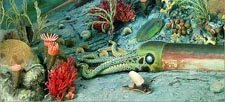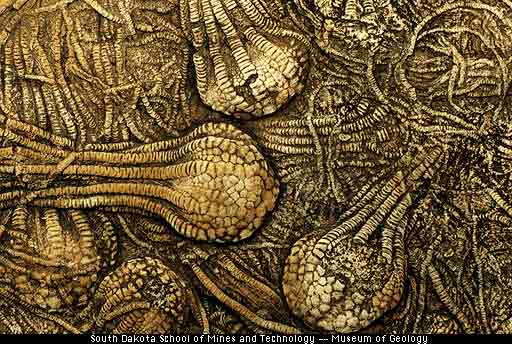 |
 |
 |
 |
 |
Produced
by the Population Genetics and Evolution class, Furman University |
||||
 |
 |
 |
 |
 |
Produced
by the Population Genetics and Evolution class, Furman University |
||||
 |
The
Ordovician: Crinoids |
 |
||
| Crinoids are
echinoderms, like sea stars and sea urchins. About 500 crinoid species
exist today, and most are free-swimming. However, there are still some,
called "sea lilies", that express the primitive sedentary morphology.
Most extinct crinoids (and a few extant ones) have a stem that anchors
the organism to a substrate and supported its pentaramous body (Borths
2008). The body, or "calyx", contains the digestive and reproductive
organs of the organism. The tube feet on the arms of this echinoderm are
oriented perpendicularly to the incoming water current in order to capture
food particles (Borths 2008). Extant crinoids are the only remaining examples
of attached, suspension-feeding echinoderms. Now, their habitat is usually
located in deep water so viewing them in the wild is quite difficult (Simison
1996).When crinoids first radiated during the Ordovician, however, they
comprise a major component of shallow reef communities. Indeed, some reef
deposits are completely composed of the carbonate endoskeletons of crinoids
(Ausich and Messing 1998). Page by Ignas Gaska |
 |
| Fossil crinoid assemblage. Picture provided by: Why files. | |
|
Ausich WI, Messing CG. 1998. Crinoidea. Tree of Life project. Accessed Feb. 2010. Borths M.2008.Crinoids in Lilliput: Morphological change in class Crinoidea across the Ordovician-Silurian Boundary. Ohio State University Thesis: pg 7. Simison WB.1996. Introduction to the Crinoidea. University of California Museum of Paleontology. Accessed Feb. 2010. |